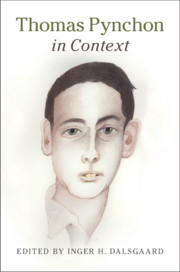Book contents
- Thomas Pynchon in Context
- Thomas Pynchon in Context
- Copyright page
- Contents
- Contributors
- Abbreviations
- Chronology
- Introduction
- Part I Times and Places
- Part II Culture, Politics, and Society
- Part III Approaches and Readings
- Chapter 34 Narratology
- Chapter 35 Genre
- Chapter 36 Postmodernism
- Chapter 37 Ambiguity
- Chapter 38 Realities
- Chapter 39 Material Readings
- Chapter 40 Digital Readings
- Chapter 41 Internet Resources
- Chapter 42 Fandom
- Chapter 43 Book Reviews and Reception
- Chapter 44 Critical Literature Review
- Further Reading
- Index
Chapter 43 - Book Reviews and Reception
from Part III - Approaches and Readings
Published online by Cambridge University Press: 31 May 2019
- Thomas Pynchon in Context
- Thomas Pynchon in Context
- Copyright page
- Contents
- Contributors
- Abbreviations
- Chronology
- Introduction
- Part I Times and Places
- Part II Culture, Politics, and Society
- Part III Approaches and Readings
- Chapter 34 Narratology
- Chapter 35 Genre
- Chapter 36 Postmodernism
- Chapter 37 Ambiguity
- Chapter 38 Realities
- Chapter 39 Material Readings
- Chapter 40 Digital Readings
- Chapter 41 Internet Resources
- Chapter 42 Fandom
- Chapter 43 Book Reviews and Reception
- Chapter 44 Critical Literature Review
- Further Reading
- Index
Summary
Eight novels published over fifty years would naturally elicit a variety of reader responses, but Thomas Pynchon’s works in particular have presented mainstream reviewers with unique challenges, resulting in widely divergent opinions and interpretations regarding such seemingly basic matters as plot, character, tone, genre, and career trajectory. For one thing, the books tend to be big, their combined length and density leading some critics to throw up their hands in despair at being able to comprehend them. In place of reasoned argument, these critics give us crazily proliferating lists of contradictory attributes in imitation of Pynchon’s own epic catalogs. Thus Gravity’s Rainbow (1973) is described as “bonecrushingly dense, compulsively elaborate, silly, obscene, funny, tragic, pastoral, historical, philosophical, poetic, grindingly dull, inspired, horrific, cold, bloated, beached, and blasted.” Meanwhile, Against the Day (2006) is “audacious, bodacious, entropic, synoptic, electric, eclectic, entertaining, hyperbraining” as well as “rambling, shambling, self-indulgent, non-refulgent, overlong, full-of-bad-song, seriously-scattered, plainly mad-hattered.”
- Type
- Chapter
- Information
- Thomas Pynchon in Context , pp. 346 - 353Publisher: Cambridge University PressPrint publication year: 2019



